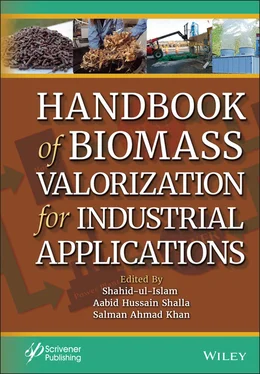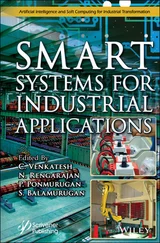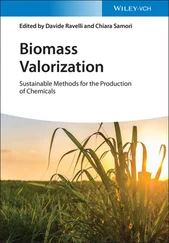Handbook of Biomass Valorization for Industrial Applications
Здесь есть возможность читать онлайн «Handbook of Biomass Valorization for Industrial Applications» — ознакомительный отрывок электронной книги совершенно бесплатно, а после прочтения отрывка купить полную версию. В некоторых случаях можно слушать аудио, скачать через торрент в формате fb2 и присутствует краткое содержание. Жанр: unrecognised, на английском языке. Описание произведения, (предисловие) а так же отзывы посетителей доступны на портале библиотеки ЛибКат.
- Название:Handbook of Biomass Valorization for Industrial Applications
- Автор:
- Жанр:
- Год:неизвестен
- ISBN:нет данных
- Рейтинг книги:4 / 5. Голосов: 1
-
Избранное:Добавить в избранное
- Отзывы:
-
Ваша оценка:
- 80
- 1
- 2
- 3
- 4
- 5
Handbook of Biomass Valorization for Industrial Applications: краткое содержание, описание и аннотация
Предлагаем к чтению аннотацию, описание, краткое содержание или предисловие (зависит от того, что написал сам автор книги «Handbook of Biomass Valorization for Industrial Applications»). Если вы не нашли необходимую информацию о книге — напишите в комментариях, мы постараемся отыскать её.
BIOMASS VALORIZATION
INDUSTRIAL APPLICATIONS
The handbook provides a comprehensive view of cutting-edge research on biomass valorization, from advanced fabrication methodologies through useful derived materials, to current and potential application sectors.
Audience Handbook of Biomass Valorization for Industrial Applications
Handbook of Biomass Valorization for Industrial Applications — читать онлайн ознакомительный отрывок
Ниже представлен текст книги, разбитый по страницам. Система сохранения места последней прочитанной страницы, позволяет с удобством читать онлайн бесплатно книгу «Handbook of Biomass Valorization for Industrial Applications», без необходимости каждый раз заново искать на чём Вы остановились. Поставьте закладку, и сможете в любой момент перейти на страницу, на которой закончили чтение.
Интервал:
Закладка:
Upgradation of bio-oils can be performed by catalytic transformation. Pyrolysis can be classified on slow pyrolysis and fast pyrolysis depending on the heating rate. Slow pyrolysis is carried out at temperatures 400–600 °C @ 0.1–1 °C/s. Fast Pyrolysis is carried out at 400–650 °C @ 10–100°C/s with a residence time of seconds only. Fast pyrolysis results in biphasic liquid with bio-oils and aqueous phase, gases and chars. Single phase bio-oils can achieve by carrying out pyrolysis at lower temperature or with catalytic system. Different reactors such as fluidized and spouted bed, ablative, and vacuum pyrolizers have been assessed for the pyrolysis [16]. Pyrolysis mechanism consists of different reactions such as cracking, decarboxylation, hydrocracking, decarbonylation, hydrodeoxygenation, and hydrogenation. Bio-oils obtained from the pyrolysis are rich in oxygen and have low energy density. The catalytic upgradation is carried out to reduce the oxygen content as water and carbon dioxide. The products obtained with catalytic pyrolysis have similar structure as that of the petrochemical products. The nature of bio-oils depends on the properties of the catalyst such acidity, metal composition, pore size [17, 18]. Pyrolysis is carried out using different alkali metals (NaCl, KCl), alkaline earth metals (MgCl2, CaCl 2), metal oxides (CaO and La 2O 3), and transition elements. The effect of transition metal (Fe & Ni) was studied by Collard et al . [19]. The catalyst containing Fe results in increased production of char with low tar formation, whereas catalysts with Ni metal catalyzed the depolymerization of amorphous xylan with high yields of furans, aromatics and hydrogen. Pd, Ru, Ni showed the selectivity towards the aromatics and showed high potential to convert the oxygenates to hydrocarbons [20]. Apart from metal catalyzed pyrolysis, zeolites are also reported in various literatures. HZSM-5, H-beta, H-Y. The acidity in zeolites favors the formation of aromatics, Ga supported on ZSM-5 increase the selectivity towards the aromatics and reduce the char formation. The desilication of zeolites studies during the fast pyrolysis of lignocellulosic biomass showed enhanced selectivity towards the aromatics with less char formation [21–23]. Lu et al . reported the K 3PO 4catalyzed biomass pyrolysis that results in high yields of phenolics derivatives. The selectivity increased with the catalyst loading first then decreased on further increasing the catalyst loading [24]. Hussain carried out the pyrolysis using cement as the catalyst to yield 7% oil, 14% water, 29% fuel gases and 50% char. Apart from the oil, it also contains acids, esters, ketones and aldehydes [25]. Shadangi et al . used alumina, CaO and Kaolin as the catalyst for the pyrolysis of biomass. Catalytic pyrolysis enhanced the quality of the oil but decreased the yield of the oil, whereas CaO decreased the viscosity of the pyrolytic oil. Catalysts such as silica with weak acidity and moderate pore size (16 nm) found to be highly efficient in deoxygenation and increased the hydrocarbon content [26, 27].
3.2.2 Gasification
Gasification is the thermal process that results in large quantities of gaseous products with lower char and ash formation. The major outcome of gasification of biomass is syn gas (CO/H 2) that can be utilized in Fischer Tropsch process to yield high value products. The reaction side products and contaminants present in biomass inhibits the catalyst and results in lower yields and selectivity of syn gas. Gasification is multi step endothermic process involving various sequential and parallel reactions. Gasification has high efficiency in chemical transform, low capital investment and distributed production. Generally, low molecular oxygenates produced during the gasification and enters the pore of the catalyst to produce gases such as CO 2, H 2, CH 4, CO, H 2O, and gaseous hydrocarbons [16, 28]. Routes to produce syn gas from biomass helps in the production of chemicals, biofuels, hydrogen and electricity. In general gasification consist of drying, pyrolysis, combustion and reduction [29]. The moisture in biomass is first removed by heating it at low temperature, then the temperature is raised to decompose the biomass to high molecular weight volatiles, tar and solid char in absence of oxygen. The products from the pyrolysis will be further oxidized to gaseous product, carbon monoxide, carbon dioxide and water. Then the reduction of gaseous products results in the production hydrogen in addition with CO, and CO 2. The formation of tar and solid char during the gasification reaction hampers the efficiency of turbine engine, hence various studies have been reported to clean up the product gas. The temperature range for the gasification is 800–900 °C at atmospheric pressure. The steam to carbon ratio varies from 0.8:1 to 1.5:1 during the gasification reaction to give hydrogen rich product gas. The tar content can be lowered by carrying out gasification in presence of catalysis that reduces the formation of tar by promoting the reforming, cracking, selective hydrogenation, and oxidation reaction [5]. The catalyst can be added in the step of gasification or can be used afterwards for the upgradation of the products, depending on their addition and role they are classified as in situ and ex situ catalytic gasification. The majorly employed catalysts are composed of alkali metal, transition metal and composite formulations. Among alkali metal catalysts sodium, potassium and caesium are found to be equally effective in lowering the combustion temperatures and increasing reaction temperatures. The highest activity of sodium is found in the range of 3 ⁎ 10 –4–1.5 ⁎ 10 –4mol of alkali per gram of biomass. Different salts of potassium as KCl, CH 3COOK, K 2CO 3were also found to be effective in improving the gasification efficiency. Vamvuka et al . [30, 31] further explored the activity of Li, Rb, Ca Na, and K containing catalysts in gasification of waste and trend obtained as follows: Li 2CO 3> K 2CO 3> CaCO 3> Rb 2CO 3> CaSO 4> Cs 2CO 3> Na 2CO 3. Calcined dolomite due its abundance, inexpensive and catalytic activity towards reducing the tar formation attracts the researcher. Various studies have been reported using dolomite as catalyst under batch as well flow conditions such as fixed and fluidized bed reactor. Calcined Dolomite also suffers the drawback of melting point which makes it unstable at higher temperature and doesn’t achieve tar conversion beyond 90–95%. The catalytic activity of noble metal (Rh/CeO 2) based catalyst lowered the gasification temperature to 600 C. RuO 2showed good catalytic activity towards the production of hydrogen under supercritical water under conditions of 44 MPa, 450 °C and a residence time of 120 min [32, 33].
3.2.3 Aqueous Phase Reforming Aqueous Phase Reforming
Aqueous phase reforming (APR) has certainly gained attention as most promising and suitable alternative for production of hydrogen as well as alkanes from lignocellulosic biomasses. The APR has several advantages over other methods as the reaction is wet or water-soluble feedstocks compatible, that can take place in both batch and continuous flow reactor, in a single step. As compared to conventional alkane steam reforming process, APR of carbohydrate is carried at relatively mild reaction conditions which facilitate water gas shift reaction leading to low CO production due to reduced decomposition rate of carbohydrates. However, in APR, methanation of CO 2and production of alkanes/alcohols competitively lowers the H 2yield [34–36]. Moreover, the type of starting raw material, design of reactor, reaction conditions and use of suitable catalyst cumulatively influence the APR reactions. APR was first popularized by Cortright et al . [37], who demonstrated mainly hydrogen production from oxygenated hydrocarbons extracted from renewable biomass and biomass waste streams. They carried the reaction at relatively low temperature and pressure (473–523 K, 15–50 bar) in single-reactor aqueous-phase reforming process using a Pt/Al 2O 3catalyst and were able to generate hydrogen-rich fuel gas with high purity and yield. Since then, numerous substrates have been tested for H 2production.
Читать дальшеИнтервал:
Закладка:
Похожие книги на «Handbook of Biomass Valorization for Industrial Applications»
Представляем Вашему вниманию похожие книги на «Handbook of Biomass Valorization for Industrial Applications» списком для выбора. Мы отобрали схожую по названию и смыслу литературу в надежде предоставить читателям больше вариантов отыскать новые, интересные, ещё непрочитанные произведения.
Обсуждение, отзывы о книге «Handbook of Biomass Valorization for Industrial Applications» и просто собственные мнения читателей. Оставьте ваши комментарии, напишите, что Вы думаете о произведении, его смысле или главных героях. Укажите что конкретно понравилось, а что нет, и почему Вы так считаете.












